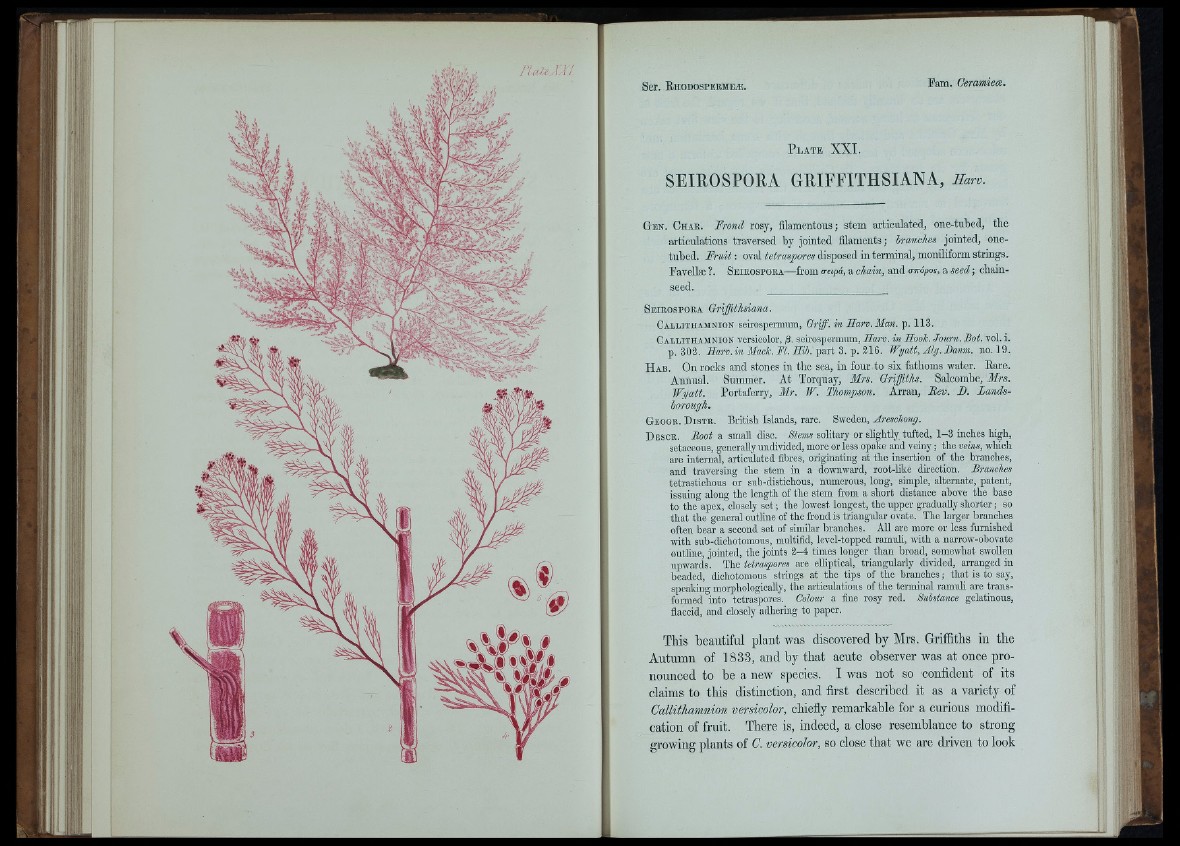
í|i! 'il
, ií
'i i -V :
ílá
L
P l a t e XXI.
SEIROSPORA GRIFFITHSIANA, Haw.
Gen. Chab. Frond rosy, filamentous; stem articulated, one-tubed, the
articulations traversed by jointed filaments ; branches jointed, one-
tubed. Fruit ; oval tetraspores disposed in terminal, moniliform strings.
Favellæ ?. S e i b o s p o e a—from o-eipó, a chain, and airó pos, a seed ; chain-
seed.
S e ik o s p o b a
C a l l it h a m n io n s e iro sp e rm um . Griff. in Harv. Man. p . 1 1 3 .
C a l l it h a m n io n versico lo r, /3. s e iro sp e rm iu n , Harv. in Hook. Journ. Bot. v o l. i.
p . 3 0 2 . Harv. in Mack. FI. Hib. p a r t 3. p . 2 1 6 . Wyatt, Alg. Banm. n o . 1 9 .
H a b . On rocks and stones in tlie sea, in four to six fathoms water. Eare.
Animal. Summer. At Torquay, Mrs. Criffiths. Salcombe, Mrs.
Wyatt. Portaferry, Mr. W. Thompson. Arran, Eev. B . Landshorough.
Geogb. Dis tb . Britisli Islands, rare. Sweden, Areschoug.
D esck. Boot a small disc. Stans solitary or slightly tufted, 1 -3 inches high,
setaceous, generaUy undivided, more or less opake and veiny; the veins, which
are internal, articulated fibres, originating at the insertion of the branches,
and traversing the stem in a downward, root-Uke direction. Branches
tetrastichous or sub-distichous, numerous, long, simple, alternate, patent,
issuing along the length of the stem from a short distance above the base
to the apex, closely s e t; the lowest longest, the upper graduaUy shorter; so
that the general outline of the frond is triangular ovate. The larger branches
often hear a second set of similar liranohes. AU are more or less furnished
with sub-dichotomous, multifid, level-topped ramuli, with a narrow-obovate
outline, jointed, the joints 2 -4 times longer than broad, somewhat swoUen
upwards. The tetraspores are eUiptical, triangularly divided, arranged in
beaded, dichotomous strings at the tips of the branches; that is to say,
speaking morphologically, the articulations of the terminal ramnU are transformed
into tetraspores. Colour a fine rosy red. Substance gelatinous,
flaccid, and closely adhering to paper.
This beautiful plant was discovered by Mrs. Griffiths in the
Autumn of 1833, and by that acute observer was at once pronounced
to be a new species. I was not so confident of its
claims to this distinction, and first described it as a variety of
Callithamnion versicolor, chiefiy remarkable for a curious modification
of fruit. There is, indeed, a close resemblance to strong
growing plants of C. versicolor, so close that we are driven to look